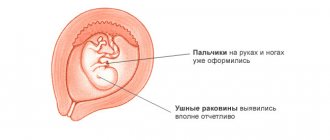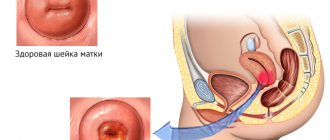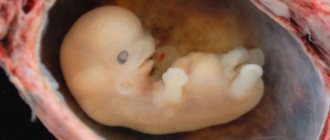You are already at 29 weeks! From this moment your life can change significantly.
By and large, now you already live only for him. Everything revolves only around the upcoming birth.
The husband is needed more for moral support and tying shoelaces. I stopped worrying about work altogether. A state of clumsiness and constant fatigue interfere with a normal existence, but you must remember what all this is for and continue to move forward.
Fetal development
In the remaining time before birth, internal organs continue to mature and prepare for independent existence.
This is what your baby looks like at 29 weeks
The skin has formed, the layer of subcutaneous fat has increased significantly. The amount of cheese-like lubricant is reduced, and the skin is partially cleared of vellus hair.
The baby's activity increases significantly in response to the voices of mom and dad, he recognizes them.
By this time, the baby should already be in the uterus in the position from which it plans to be born.
The fetal muscles have become stronger, and its movements cause pain to the mother.
But it’s too early for him to be born - his lungs are not yet able to cope with breathing on their own.
Special changes occur in internal organs:
- Liver cells mature and arrange themselves in the order characteristic of a mature organ. The organ is preparing to perform its function;
- the adrenal glands begin to actively produce substances similar in structure to androgens;
- the formation of the pancreas ends, it supplies the baby with insulin in sufficient quantities;
- The fetus independently controls its body temperature.
Nerve connections continue to improve - the baby is more awake than before, and, as a rule, the mother always knows when the baby is not sleeping.
The baby's height and weight increase significantly; during the entire third trimester, he can become five times heavier.
The baby's movements become more conscious - he sucks his finger, scratches himself behind his ear, smiles, sticks out his tongue.
Your body
Along with standard obstetric examination procedures (weighing, measuring blood pressure and abdominal circumference, listening to the fetal heartbeat with an obstetric stethoscope), when you visit a doctor, you are now offered to undergo fetal cardiotocography (CTG). This is a hardware study of the fetal heartbeat and the condition of the uterus. CTG allows you to monitor the child’s heart rate at rest and during activity. In this way, it is possible to track the development of the child, make sure that all processes in his body are proceeding correctly, that the “environment” of his environment (the mother’s uterus) is in perfect order, that the baby receives all the necessary substances through the placenta and umbilical cord.
In some cases, already at 29 weeks the baby assumes the position in which it will remain until the birth itself. Ideally, this is a cephalic presentation, in which the baby is turned with his head towards the birth canal, that is, now he is located upside down in your stomach. If the baby has not yet turned over, do not worry that by the time of birth he will have an incorrect presentation - legs, and the birth will be complicated. The baby still has enough time to find a comfortable position.
Now the doctor can easily determine the presentation of your child during an examination without an ultrasound, but only with the help of an obstetric stethoscope. It’s just that if the baby is already hanging upside down, his heartbeat can be heard below your navel, and if he hasn’t turned over yet, then above.
Your feelings depend on this position of his. The baby, having prepared in advance for childbirth and taking a position upside down, rests his legs against his mother’s ribs, which is why sometimes she feels strong and rather painful blows in the hypochondrium. If the baby has not yet turned over, the most painful tremors will occur in the area of the mother’s lower abdomen. In all cases, the child's kicking can cause discomfort to the mother. But this should not upset you at all, because strong blows indicate the strength of the little legs and the health of the tiny “fighter”. In addition, the pain from the child’s blow goes away instantly and does not cause complications for the mother.

If you really can’t bear the naughty baby, try changing your position, walking or talking quietly to him, and stroking his belly. That is, learn to negotiate with your child even before he is born. Scientists say this is very possible.
Braxton Hicks contractions at 29 weeks pregnant
As an unusual sensation, you may notice irregular cramp-like contractions in the lower abdomen. You feel tension that has arisen for no reason. These contractions are not accompanied by pain and go away the same way they appeared - suddenly on their own. These are the so-called training contractions, with the help of which the uterus trains in preparation for childbirth. In different women they appear at different times, but are typical specifically for the last months of pregnancy. It often happens that they begin only in the last days of pregnancy and a woman who has not encountered them before takes them for the beginning of real contractions and rushes to the maternity hospital. After examination, such an expectant mother is sent back home and told to be more patient. The fundamental difference between training and real contractions is regularity and pain. The first ones appear and disappear unsystematically and can be repeated several times. The second ones, having begun, do not stop, but become more and more painful, more frequent and longer lasting.
So, if a couple of times you noticed that your lower abdomen seemed to be petrified, don’t worry - this is “training” for your body. At 29 weeks, only constant nagging pain in the lower abdomen or too frequent tension can be alarming. In this case, be sure to contact your doctor as soon as possible.
Ultrasound at 29 weeks of pregnancy
Ultrasound at this time is not a mandatory study and is prescribed when controversial issues arise.
During the procedure, the size of the fetus, its individual parts, the condition of the organs, their relationship with each other, blood flow in the mother-placenta-fetus system, the condition of the placenta and cervix are assessed.
What's happening to the baby
By the end of the twenty-seventh week, the dimensions of the fetus are as follows: the baby’s average weight is 1200 g, and his height is 37 cm. The diameter of the head is 73 mm, the chest is 74.5 mm, and the abdomen is 79 mm. This size of the tummy is due to the fact that the child’s liver is disproportionately larger. If an adult had the same proportions as a baby, he would need a cart to carry this organ with him.
This is due to the fact that now liver cells perform very important functions, the main one of which is the processing of destroyed red blood cells. If its work is disrupted, then newborn jaundice . This condition can be physiological or pathological and is associated with increased levels of toxic bilirubin in the blood. Its main external manifestation is a yellow tint to the mucous membranes, skin and whites of the eyes.
The circulatory system still functions in a special mode: the heart contracts at a frequency of 150 per minute, and mixed blood flows predominantly through the vessels. It is formed from the mother’s arterial blood coming through the umbilical cord and the baby’s venous blood. Since the oxygen content in it is low, the baby’s tissues are resistant to hypoxia. This is a kind of preparation for childbirth, during which the baby experiences a lack of nutrients.
Now the baby’s body accumulates not only brown fat, rich in energy, but also ordinary fat cells, due to which the mass quickly increases. Its deposition in the cheek area is especially important, as it helps the baby create negative pressure in the oral cavity when sucking.
The baby is becoming increasingly cramped in the uterine cavity, so it is very likely that at this stage he will already take his final position upside down. This is also due to a decrease in the amount of amniotic fluid.
Photo of ultrasound of the fetus at 29 weeks of pregnancy
What happens in your body at 29 weeks?
The belly continues to grow and increase in size. A large uterus puts pressure on the abdominal organs, which aggravates constipation. It also presses the stomach against the diaphragm - heartburn appears and breathing becomes difficult.
A heavy chest increases the load on the shoulder girdle, and by the evening it results in discomfort in the spine and neck.
It takes two people to breathe, the heart also works at an increased rate - mom feels an almost constant feeling of fatigue. Appetite also increases, urination becomes more frequent.
The nipples become rougher, the halos become darker. The breast produces colostrum, although in small quantities.
If suddenly you are faced with such a nuisance as urinary incontinence when coughing and sneezing, you can start doing Kegel exercises. They will help strengthen your pelvic floor muscles.
Woman's feelings
The seventh month of pregnancy begins. Mom’s health is not as rosy as it was in previous weeks. The fetus has grown noticeably, the pressure of the uterus on the organs is becoming more and more sensitive. Accumulated fatigue makes itself felt.
In the last three months, a woman experiences health problems, even if her pregnancy was easy before. One of these problems is back pain. Veins in the lower extremities may also expand.

29 weeks of pregnancy, mommy feelings
The weight gained by a woman during pregnancy is 8.6 kg. It consists of the weight of the baby, amniotic fluid, weight of the uterus and the amount of blood. The expectant mother's belly continues to grow.
Unpleasant sensations may appear in the pelvic and chest areas. All this happens due to the growing fetus: every day it needs more space. Therefore, the uterus puts pressure on the organs, and they move slightly out of their places. So pressure on the stomach provokes frequent attacks of heartburn.
By week 29, a woman’s body releases the hormone relaxin. It helps relax the pelvic bones. This will help the baby go through the birth process painlessly during the birth process.
Some pregnant women may experience late toxicosis at 28 weeks. Doctors call it gestosis.
This condition of a woman is extremely difficult to bear. Its symptoms may include nausea, swelling, high blood pressure, and the presence of protein in the urine. When diagnosed with gestosis, a pregnant woman quickly gains weight.
All these symptoms are observed in women who are pregnant with their first child or twins, suffer from pyelonephritis, diabetes mellitus, hypertension, STDs or vegetative-vascular dystonia.

28 weeks of pregnancy, gestosis
To get rid of gestosis, a woman must fight extra pounds, swelling, and impaired urine flow. The first thing you have to do is limit your consumption of salty foods, and drink no more than 1.3 liters of liquid per day, including first courses. Next, the water should be replaced with healthy decoctions of rose hips, lingonberry leaves, bearberry and cranberries. The basis of the diet should be foods high in protein. These include lean meat, fish, eggs and cottage cheese. Do not exclude fresh vegetables. Restrictions apply to flour and sweets.
In order for the outflow of urine to be within normal limits, a woman should take the knee-elbow position 5 times for 10 minutes every day. This exercise is best done on the floor; it will help get rid of kidney problems and back pain.
How you feel at 29 weeks
The internal feeling of happiness can also be overlapped by anxiety, fear of the upcoming birth. Don’t be afraid to talk about it - you can always find a listener, if not your husband, then your mother, if not your mother, then your friend. You can meet the same pot-bellied lady in the park - you will have something to talk about.
Listen to your baby's movements - by their intensity and strength you can always determine how he feels and what he wants at that moment.
Keep an eye on your sensations - increasing swelling of the limbs is not a very good prognostic sign - you need to inform the doctor about this and arrange a fasting day.
Discharge from the genital tract
Light, moderate discharge with a slight sour odor is considered normal. If you suddenly find copious liquid yellowish discharge, this could be amniotic fluid, especially if such discharge was preceded by sudden movements or a blow to the abdominal area.
Thick yellow or green discharge with an unpleasant odor indicates the development of an infection in the vagina. It is impossible to cope with this on your own. Such discharge disappears only after using medications - these are most often local suppositories and tablets. Douching with medications during pregnancy is contraindicated.
What kind of discharge can be considered normal?
At this stage, leucorrhoea of moderate volume, with a milky tint, without foreign inclusions, and without odor, is considered normal. The normal version is not a sharp sour aroma.
The appearance of a secretion that looks like water and has a yellowish tint may indicate leakage of amniotic fluid. Even a small amount of such liquid requires urgent consultation, as there is a risk of damage to the membranes of the fetus.
The appearance of bleeding is a sign of placental abruption or previa. Often this symptom is accompanied by abdominal pain. In some cases, this condition signals the onset of labor. In this case, you need to call an ambulance.
If the shade of the leucorrhoea has changed, you should consult a gynecologist, as this phenomenon is a sign of infection. Often the secretion is accompanied by unpleasant sensations in the intimate area.
Photos of bellies at 29 weeks
Examinations at 29 weeks
The following measurements are required:
- measuring blood pressure in both arms;
- weight measurement with assessment of total gain and weekly gain;
- Using a stethoscope, the child’s heartbeat is listened to, its frequency and rhythm are assessed.
And you will again have to take a urine test - based on the results of which the doctor will be able to determine how the body of a pregnant woman functions.
Risks at 29 weeks
As the fetus grows, the risk of cervical dilatation and premature birth increases. Therefore, be sure to wear a bandage, even at home, if you plan to do household chores or walk outside with your child. Try to avoid traveling and walking long distances.
The reduced immunity of pregnant women always leaves the opportunity for bacteria and viruses to cause an inflammatory process - do not forget about maintaining personal hygiene, avoid large crowds of people so as not to catch a respiratory infection.
Important at 29 weeks
Try not to burden your already working body to the limit. Perform only those actions that do not require a large amount of energy. You can wash the dishes and cook the food yourself, but let your husband do the shopping. He will help you hang out the laundry and beat out the carpet.
It's time to change your wardrobe once again - everything from socks to outerwear should be comfortable and not restrict your movements.
If you are still working, treat yourself to a cool foot bath, and your husband can give you a foot massage, this will help relieve swelling and discomfort.
If you still haven’t made a list of necessary things, now is the time; it will help your family buy a dowry for your baby while you are in the maternity hospital
Gymnastics at the 29th - 32nd week
Swing your legs
- STEP 1. Stand straight with your feet together. Interlace your fingers and place your hands on your head.
- STEP 2. Shift your center of gravity to your right leg, and swing your straightened left leg as high as possible forward and then back. The toes of the left foot point upward during the swing; in the middle of the swing movement, the ball of the foot only glides slightly on the floor. When performing the exercise, stay straight and calm at all times.
- STEP 3. Take ten swings forward and back, first with your left and then with your right leg. Shake your arms and legs. Repeat the exercise two more times.
Leg grab
- STEP 1. Stand up straight, keep your legs together, and maintain proper posture.
- STEP 2. Bend your left knee and grab the back of your foot with your left hand. Use your hand to pull your left heel toward your left buttock.
- STEP 3: Maintaining balance, extend your right arm out to the side at shoulder height. Make ten rotations forward and ten backwards with your right hand.
- STEP 4. Return to the starting position and shake out your arms and legs. Repeat the exercise with the other arm and leg.
Nutrition at 29 weeks
A pregnant woman's diet should consist of easily digestible, well-heat-treated food. It is necessary to reduce the consumption of fatty, fried and spicy foods. Instead, you can please yourself with dried fruits, nuts, and yoghurts. It is no less tasty, but more healthy.
Alcohol, fast food, canned factory products, soda and exotic foods are still prohibited (if your diet before pregnancy was not rich in seafood, you should not introduce them now - it is possible to provoke an allergy in the baby).











